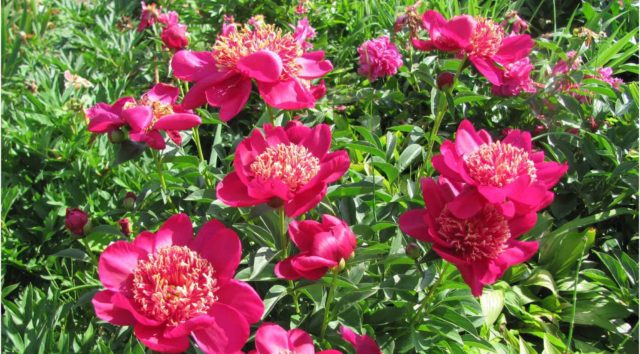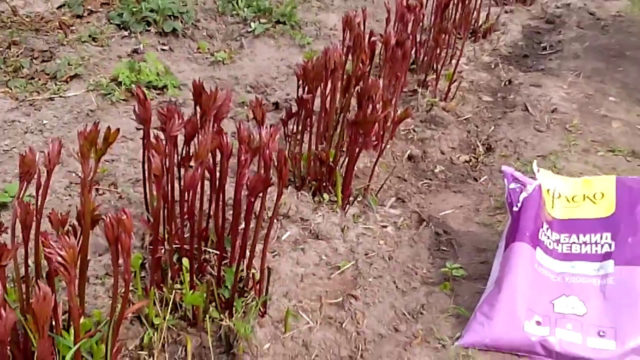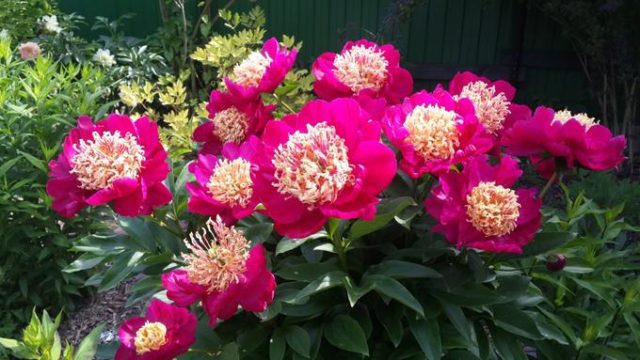Content
In the mind of most people, peony flowers should be large and double. Many of these varieties grow on plots. But some gardeners choose varieties with a Japanese type of flower, one of them is the Nippon Beauty peony. Although it does not look completely familiar, it deserves no less attention from flower growers.
Description of peony Nippon Beauty
The herbaceous peony of the Nippon Beauty variety is a perennial with a strong rhizome. Forms a compact but powerful shrub of dark red stems with dark green foliage. Plant height - 80-90 cm. Stems are strong, do not decay under the weight of flowers.
It does not need special care, is cold-resistant, withstands rather severe frosts, so it can be planted in almost all regions of Russia, except for the most northern ones. Grows well in a sunny or semi-shaded area. Prefers moderately dry soil, but rich in nutrients. Doesn't like to grow in dense soil.
Flowering features
Nippon Beauty peony flowers consist of large, dense petals, the tops of which are bent inward. Flowers of the Japanese type, diameter 15-16 cm. The petals are colored evenly, in a rich purple-red color. In the center are yellow staminodes. Flowers of this variety have no aroma. They bloom late - in June-July, for a long time, abundantly. How the Nippon Beauty peony blooms can be seen in the photo.

Flowers of the Nippon Beauty variety are softer and lighter, with a dense core
Application in design
Peonies can be beautiful in single plantings and in small mixed groups with other plants. They can be combined with low colors that will not cover them with themselves. The timing of flowering should be selected so that they begin to open before the peony, and are pumped later. This way you can extend the period during which the flower bed will remain decorative.
It is important to pay attention not only to how and when the plants will bloom, but also to the attractiveness of their leaves and stems: when the flowering is over, they should still decorate the flower bed.
As for the color range of plants surrounding peonies, it can be varied. Nippon Beauty is quite bright, they will not be lost against the background of other colors.
In pots, the peonies will be cramped, they will not be able to develop and bloom normally. If you want to decorate your home inside, you need to choose undersized varieties that were bred specifically for growing in pots.
Reproduction methods
Although peonies sometimes form seeds, this method of propagation is not suitable for varietal flowers. Such plants do not inherit the characteristics characteristic of the variety, moreover, it is long and laborious to grow them from seeds.
It is much easier to propagate Nippon Beauty peonies vegetatively - by cuttings or by dividing the bush. If the last method is chosen, then the transplant should be started at the end of August or in September. By this time, the vegetative processes occurring in the plant slow down, it tolerates the transplant normally. By dividing the bush, you can propagate peonies in the spring, but you need to have time to do this before the stems begin to grow. Each section must have growth buds. The divided bush is transplanted immediately into the planting holes, which are prepared immediately before planting.You may not transplant the entire bush, but only dig up the rhizome on one side, separate a piece of root with buds, transplant it, and cover the cut with soil.
The method of propagation by cuttings is also suitable for a peony of this variety. Cuttings 10 cm long are cut from the roots, then planted in a warm, fertile, moist substrate. Gradually, new young roots and growth buds are formed on them. When this happens, they are transplanted to a permanent place. Plants will bloom in about 3-5 years.
Green cuttings are cut from the bottom of the stems, capturing the root collar.

Young stems of peonies are first rooted, and then planted in a permanent place
Landing rules
The best time to plant Nippon Beauty peonies is early autumn. You can transplant in October, but not less than a month before the onset of a stable cold snap. In the spring, you need to plant plants as early as possible, do not wait until it gets warmer, since they wake up early, and if you do not have time with the transplant before the start of sap flow, the peonies will not take root well.
Special attention should be paid to the quality of the planting material. Only healthy, properly developed specimens take root and grow well. They should have strong, not dried out roots, stems and leaves without traces of disease or pest damage. The day before planting, the roots are soaked in a solution of a growth stimulant, this helps the seedlings to root faster.
The area in the garden, which is optimal for growing peonies, should be on the sunny side or in partial shade, protected from strong winds. In completely shaded areas, they will not grow well, the stems will begin to stretch, the flowers will be small and few in number. They prefer loamy soils, bloom earlier on sandy loams, but the flowers are less decorative. The acidity of the soil is neutral or slightly alkaline, acidic soils must be calcareous before planting.
For each bush, a hole is dug 50-60 cm in diameter. A distance of 90-100 cm is left between them. First, a drainage layer is poured into the holes, then fertilizers (humus, compost and ash) are mixed with a part of the excavated earth.
The process of planting a peony seedling looks like this:
- Distribute peony roots evenly.
- Lower it to the middle of the hole.
- Watered when the water is absorbed, sprinkle with earth.
- They compact it a little at the roots.
- Cover with a thin layer of mulch.
Follow-up care
In the first season after planting, the Nippon Beauty peony will not bloom, at this time it grows vigorously and gains green mass. If, nevertheless, the buds will form, then you need to cut them all off so as not to deplete the plant. It is not necessary to feed it in the first year, the nutrients that came with the fertilizers introduced into the planting hole are enough.

Lush flowering begins only a few years after transplanting
Watering immediately after transplanting should be thorough until the bush is completely rooted. An adult plant is not often watered, since it has deeply penetrating roots that can draw moisture from the soil. But if there is a prolonged or intense heat, you need to take care of additional moisture and adult peonies. To reduce the number of irrigations, it is advisable to mulch the soil surface with a layer of straw, hay, leaves or lay agrofibre. If there is no mulch, the soil should be loosened after each watering.
Top dressing of adult Nippon Beauty bushes is carried out 3 times per season:
- Early in the spring (nitrogen fertilizers are applied, watered with slurry, saltpeter or urea).
- Before flowering (nitrogen, phosphorus and potash fertilizers).
- After flowering or at the end of summer (only fertilizers containing phosphorus and potassium are used).
On poor soils, you can feed the peonies again in the fall before preparing for winter.
Preparing for winter
After the first frost, the bushes of Nippon Beauty peonies are cut off - all the stems are removed at the root. They do not need to be sheltered, they tolerate the cold well, but if, according to forecasts, winter is frosty, a mulch shelter will not hurt. The next year, as soon as it gets warmer, it must be removed and replaced with a new layer.
Pests and diseases
The most common pests of peonies are ants, they climb on buds and blossoming flowers and spoil them. If there are many insects, they may not open. You can drive away ants with the help of folk remedies - infusions of tansy, mint, cloves, mustard, anise, laurel, garlic or other herbs with a pungent odor that can scare off pests. If the infusions do not cope with their task, you will have to use synthetic insecticides.
The same applies to another pest of peonies - bronzes, who also like to visit flowering bushes. To combat them, it is necessary to use folk remedies and only then agrochemicals.
The variety is resistant to diseases, but in damp cool weather it can be affected by gray rot. Sick buds are to be destroyed.

With proper care, the bush blooms profusely and is less sick
Conclusion
Peony Nippon Beauty does not belong to the widespread double-flowered type, but this does not make it less interesting. It can be combined with other varieties of culture, if the shades are harmoniously selected. This variety, like all peonies, is distinguished by its durability, it can grow in one place for decades.
Reviews about peony Nippon Beauty








